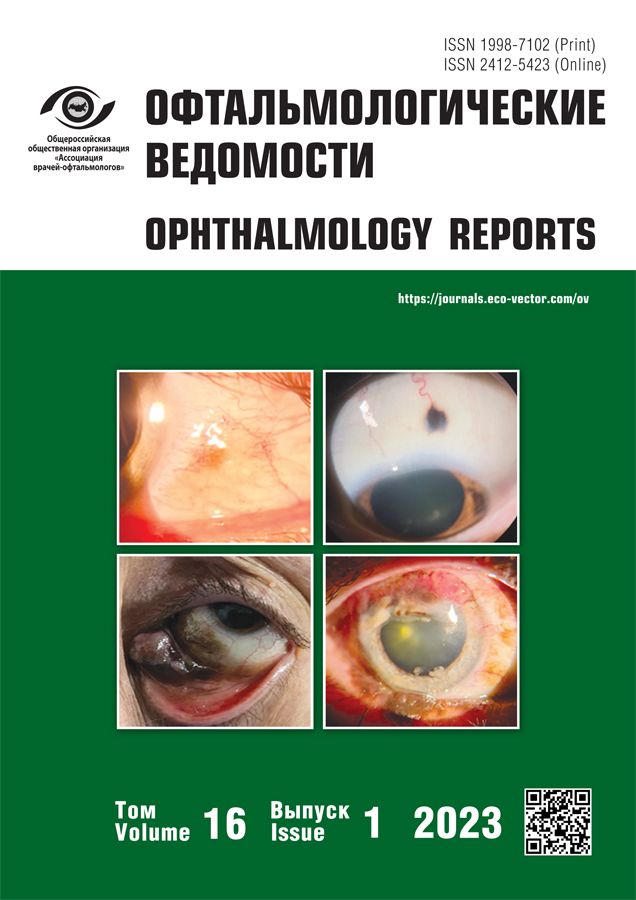A giant foreign body of the orbit. A clinical case
- Authors: Filatova I.A.1
-
Affiliations:
- Helmholtz National Medical Research Center of Eye Diseases
- Issue: Vol 16, No 1 (2023)
- Pages: 91-98
- Section: Case reports
- Submitted: 11.07.2022
- Accepted: 22.12.2022
- Published: 09.04.2023
- URL: https://journals.eco-vector.com/ov/article/view/109283
- DOI: https://doi.org/10.17816/OV109283
- ID: 109283
Cite item
Abstract
The article describes a casuistic case of a long asymptomatic stay of a giant foreign body in the orbit and of its removal. Immediately after the injury and at primary surgical treatment, the foreign body was not diagnosed. The patient did not have any complaints for a long time, then gradually there was a periodic double vision when looking straight ahead, a dense formation under the eyebrow began to be revealed by palpation. The foreign body was successfully removed almost a year after the injury.
Full Text
About the authors
Irina A. Filatova
Helmholtz National Medical Research Center of Eye Diseases
Author for correspondence.
Email: filatova13@yandex.ru
ORCID iD: 0000-0002-5930-117X
SPIN-code: 1797-9875
Scopus Author ID: 7004245888
Dr. Sci. (Med), professor, MD of highest qualification, head of the Department of plastic surgery and eye prosthetics
Russian Federation, MoscowReferences
- Polyak BL. Voenno-polevaya oftal’mologiya. Leningrad: Medgiz, 1957. 339 p. (In Russ.)
- Gundorova RA, Stepanov AV, Kurbanova NF. Sovremennaya oftal’motravmatologiya. Moscow: Meditsina, 2007. 256 p. (In Russ.)
- Neroev VV, Gundorova RA. Diagnostics and removal of foreign bodies: analysis of institute developments for 40 years. Ophthalmo logy in Russia. 2010;7(2):7–10. (In Russ.)
- Korotkikh SA, Bobykin YeV, Stepanyants АВ, Pudov VI. Complex diagnosis of fragment injuries of the eye and orbit. The Russian annals of ophthalmology. 2008;124(6):17–21. (In Russ.)
- Danilichev VF, Shishkin MM. Sovremennaya taktika khirurgicheskogo lecheniya boevykh ognestrel’nykh povrezhdenii glaz. Military medical journal. 1997;318(5):22–26. (In Russ.)
- Danilichev VF. Sovremennye boevye ognestrel’nye raneniya glaz: Lecture for listeners of the 1st and 6th fac. VMA named after S.M. Kirov. Leningrad: VMA, 1991. 24 p. (In Russ.)
- Neroev VV, Bykov VP, Kataev MG, et al. Some aspects of clinical picture and treatment of modern bullet wounds of visual organ. Disaster Medicine. 2014;(4):33–35. (In Russ.)
- Gundorova RA, Kataev MG, Bykov VP, et al. Eye injuring by rubber bullets. Russian journal of clinical ophthalmology. 2008;9(3):98–101. (In Russ.)
- Nikolaenko VP, Mikhaylova YA. A giant foreign body of the orbit an maxillary sinus. Ophthalmology Journal. 2013;6(1):78–81. (In Russ.) doi: 10.17816/OV2013178-81
- Kasatkina OM, Nikolaenko VP, Kasymov FO, Panova TYu. Penetrating cranial injury with giant intraorbital foreign body. Ophthalmo logy Journal. 2016;9(1):77–82. (In Russ.) doi: 10.17816/OV9177-82
- Fulcher TP, McNab AA, Dullivan TJ. Clinical features and management of intraorbital foreign bodies. Ophthalmology. 2002;109(3): 494–500. doi: 10.1007/s00330-001-1167-3
- Chen J, Shen T, Wu Y, Yan J. Clinical characteristics and surgical treatment of intraorbital foreign bodies in a territoriary eye center. J Craniofacial Surg. 2015;26(6):486–489. doi: 10.1097/SCS.0000000000001973
- Gundorova RA, Brovkina AF, Val’skii VV, Bagaturiya TG. Diagnosticheskoe znachenie KT pri posttravmaticheskoi khirurgii oskolochnykh ranenii glaza. The Russian annals of ophthalmology. 1986;102(6):45–47. (In Russ.)
- Stepaniants AB. Potentialities of magnetic resonance ima ging and computed tomography in the diagnosis of visual organ injuries. The Russian annals of ophthalmology. 2006;122(4):46–49. (In Russ.)
- Davydov DV, Serova NS, Pavlova OYu. Risk prediction of posttraummatic enophthalmos development on the basis of orbital volume calculations using multislice computed tomography data. Ophthalmology Journal. 2018;11(3):26–33. (In Russ.) doi: 10.17816/OV11326-33
- Otto CS, Coppit GL, Mazzoli RA, et al. Gaze-evoked amaurosis: a report of five cases. Ophthalmology. 2003;110(2):322–326. doi: 10.1016/S0161-6420(02)01642-1
- Segal S, Salyani A, DeAngelis DD. Gaze-evoked amaurosis secondary to an intraorbital foreign body. Can J Ophthalmol. 2007;42(1):147–148. doi: 10.3129/can.j.ophthalmol.06-123
Supplementary files













